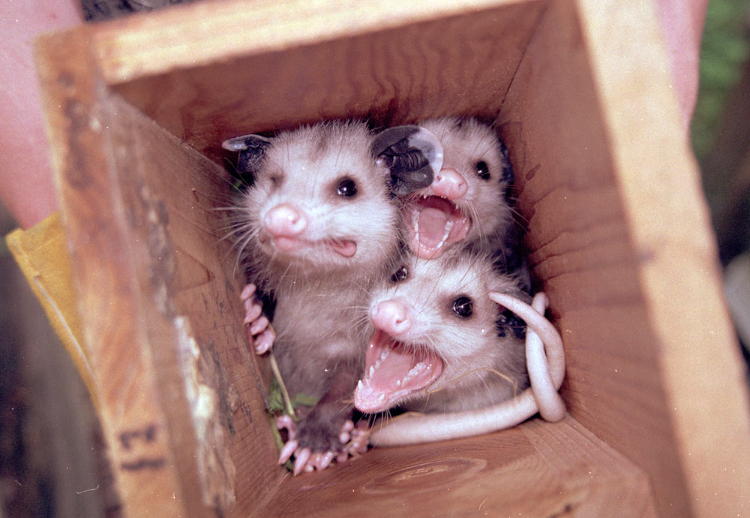
For this week’s storytime, we have a trio of Virginia opossums (Didelphis virginiana) intimating far more drama than was actually present, which is why I like this image so much. No, there was no imminent danger, even if I stuck my hand in there.
You’re peeking into the nest box of some rehab patients that we had, back in ’96 or ’97, at the facility where I worked, and these are juveniles just a couple of months old, if it’s not immediately apparent. Juvenile opossums are experts at appearing vicious and bloodthirsty, while the adults tend to be less so; this trait protects the young, which would be easy pickings for many predators in the area because they’re not fast, and not adept at finding shelter when danger threatens. So they display this mouthful of remarkable teeth, growling and hissing as needed, and it usually works. But the funny thing is, they rarely ever use these teeth in defense, and don’t have to – it’s a threat display, like butterflies with eyespots, or these guys.
Five or six years previously, I had been called out during rescue duty on a ‘baby possum’ call, and arrived at a small house bordering the woods to find one as young as these, cornered alongside a stoop by three dogs, all massing about a hundred times as much as the opossum (you shouldn’t ask why the caller or owners did not take control of these dogs long before I arrived; this is rural North Carolina, and it would take more sense than is often found in these parts. It’s the bible belt after all, so people aren’t ever expected to think.)
The amusing bit is, while any of the dogs alone could have easily killed the opossum in one snap, none of them could even approach – the opossum was crouched with that mouth wide open and displaying those needle-sharp teeth, occasionally doing short lunges at the dogs with a barking, creaking growl, a sound with a phenomenal amount of malice behind it. I managed not to actually say, “Can you get these fucking dogs out of here?” while communicating the exact same sentiment, and could eventually approach the opossum without any interference from canines. I was treated to the same display, but as I reached in with heavily-gloved hands, I found the juvie easy to scoop up, whereupon its fury vanished and it merely struggled feebly. I popped it into a cat carrier (don’t ask me why we did not have specialized possum carriers, but we didn’t,) and carried it back to the van to release in a safer locale. The opossum, for its part, did not hide in a back corner of the carrier or burrow under a towel as you might expect, but swarmed up the wire door and hung upside-down from the bars, tail tightly wrapped around the wire for security.
I actually had to make a detour on the way back to the shelter to show my roommate, because prodding the opossum gently in the exposed belly or feet, while it hung inverted from the carrier-front, would produce this fantastic creaking, groaning sound, exactly what we want doors in haunted houses to emanate; this wasn’t anything more than a mild keepaway warning when its threat display had failed. As expected, an examination revealed no wounds or issues at all – the dogs had been unable to overcome their fear at this minuscule marsupial’s bravado.
Years later, I came across another outside a dumpster while in The Girlfriend’s presence (this was not a date, so hush,) and knowing their habits, didn’t even bother with the gloves this time. Despite a few barks and creaks, I slipped my hand under it and held it aloft for a quick exam while its tail curled tightly around my fingers for security, enough that it could actually dangle supported only by its tail – I did this momentarily just to demonstrate. The adults lose this ability, because they don’t need it; it’s one of the ways that the young remain attached to the back fur of their mother while she forages, the other being their agile little toes. I had myself almost completely forgotten about this incident, but was reminded not long back when The Girlfriend repeated it to someone else – apparently it stuck with her better than with me.



















































